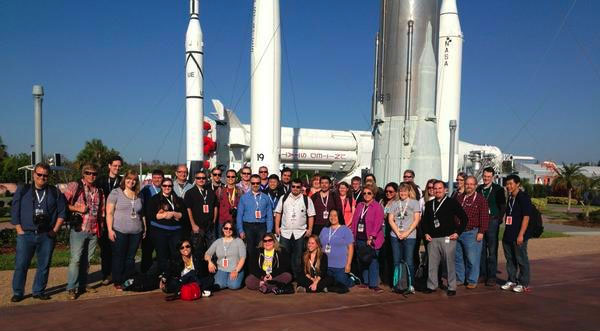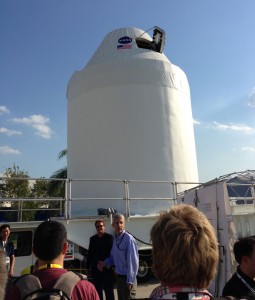November 02, 2012 Social MediaTravel
NASA Social: Day 1
It’s hard to come back at the end of the day and remember all of the awesomeness that was NASA Social. Even harder will be breaking it down to a blog post that not only makes sense, but has some value to you, the reader.

Warning: This WILL be full of geeking out and general nerdery.
At the start of the day, we introduced ourselves via Twitter handles, names, and an interesting fact. As last in the circle, my two stories had been told (the journey to Atlantis and the last shuttle launch). I declared that I am probably one of the luckiest people, and that I was so happy to be a part of a group of people as geeked about space, shuttles, and social media as I am. We quickly moved in towards the rocket garden for a group photo before we saw Kennedy Space Center, learned about NASA’s old and new programs, and had general nerd out sessions.
Our first stop of the day was a hard hat tour of the soon-to-be home of Atlantis at the Kennedy Space Center Visitor Center. This involved actual hard hats that had a badge for Atlantis as well as bright yellow vests. Our introduction to said fashionable items included calling them PPE (Personal Protection Equipment), a term often used in high school chemistry for safety goggles. Happy to oblige you, NASA.
It’s just short of astounding the size of the building. The plan is to build an entrance way with old rocket boosters and the shuttle to hang from the ceiling as it would look while in orbit. To know in less than 24 hours we’re going to see it be moved to this facility is a thought that simply blows my mind.

This was followed by lunch. But before we could make it out to KSC’s new classy cafe, a pit stop occurred with one of the most interesting conversations occurred. Mike, Cindy, Samer (fellow Spartan), and I stopped to talk with Jason Townsend, NASA’s Deputy Social Media Manager. He told us all about the formation of the idea for having Mars Curiosity check in on Foursquare. This was more than just a simple process of a good idea and approval. It went through several stages and “ok’s” before everyone was on board, including but not limited to NASA’s social media and PR team, the engineer’s, and Foursquare execs. This event meant that Foursquare not only had to approve, but they had to completely rethink the information design. Foursquare was designed for tracking people’s latitude and longitude in relevance to Earth. To map an item on another planet meant a complete overhaul.
Was it worth it?
It certainly helped garner interest not only in the Mars Curiosity mission, but also for NASA as a whole. This was taking the launches and explorations to a whole new level, reaching an audience much larger than those who actively attend such events or watch them on television. Social means longer and more dedicated engagement by a larger group of people. To me, this is absolutely brilliant. A platform like Foursquare (which seems to have recently resurged in popularity) gets a boost from the high profile client as well as creates a new level of dedication and interaction. I’d put a good wager that several people joined foursquare just to follow along with Mars Curiosity. It’s cool guys, I would do the same thing (if I wasn’t already on Foursquare).
Moving forward.
There was still a full afternoon of activity to go. The afternoon started with the highlight of the day (and our lives): standing in front of Atlantis, up close and personal. The NASA Social Team didn’t lie when they said “photo opportunity of a life time.” I’m pretty sure this constitutes for a third, if not more, of my photos from today. For this, I have no shame. Only pride. Unfortunately, many of them were corrupted by poor backlight. Hopefully tomorrow will be better.
We moved on to a press event where we heard about the Space Launch System (SLS) and Orion, Commercial Crew Program, Launch Services Program, Landsat, and more. It was broadcast on NASA TV, and we were the primary question holders. It was great to speak to these brilliant developers, engineers, and business managers who take on the core businesses of NASA. Each plays an essential role internally and externally to make the organization work. My question was about the commercial crew program: Does NASA learn from their commercial partners and vice versa? Is there any collaboration?

Oh hey there Orion capsule replica.
We ended the day with a discussion about Orion and the future of manned space travel. We saw a life size replica of the capsule which would carry the astronauts and heard from the leading engineers. It was great to see that the future is coming soon. There is still hope for the boys and girls who want to grow up and be astronauts.
So, here’s the big questions: Why does this matter? Who cares that I went to some social media event with NASA. Why is it relevant to you, your life, and social media?
The answer has multiple branches. First off, the reason NASA does this is to spread awareness about the various programs. People assumed that with the end of the shuttle launches came the end of NASA and Kennedy Space Center. This simply isn’t true. Yes, an era of space flight is over. But the shuttles (while miraculous) were very antiquated. Why use technology from the 60s to get to space, when NASA can build the latest and greatest. That’s what Orion is going to do. In about 20 years, people will be going back into space in a modern rocket. It’s safer and allows travel into deep space (journeys such as Mars, Jupiter’s moons, asteroids, etc).
The second branch is how revolutionary the entire project of NASA Social is. They’ve been running it since 2009, recently after Twitter really started to become a mainstream social tool. How many government industries do you know that let you look inside the inner depths? I can’t name that many. NASA takes it to a whole new level, involving various different social networks, a full social team, as well as inviting outsiders to help spread the word. It’s genius marketing. By getting major stakeholders to take interest in such events at KSC and other NASA facilities, it will be easier to secure funding and the people’s trust. This creates jobs and future technologies to which we cannot even dream.
I highly encourage you to try to register for a NASA Social event. It’s only been one day, but the value of coming here and meeting all of these space geeks has far surpassed any expenses.